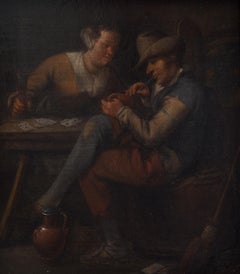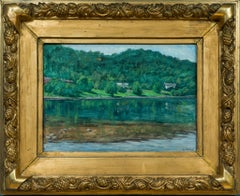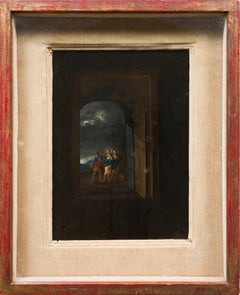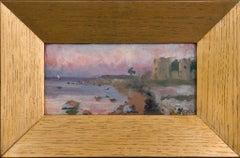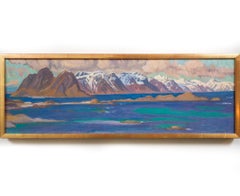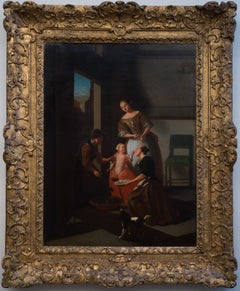Stockholm - Art
to
86
145
95
90
37
21
Overall Width
to
Overall Height
to
39
142
199
8
21
53
31
16
14
7
2
7
2
1
18
56
42
26
9
7
3
2
226
150
4
181
71
64
58
54
42
28
25
25
23
22
21
18
16
15
14
14
13
13
12
350
302
184
184
62
6
5
2
2
2
342
6
232,861
151,592
Item Ships From: Stockholm
The Card Players by a Flemish 1600s Artist
By Flemish School, 17th Century
Located in Stockholm, SE
Flemish 1600s School
The Card Players
oil on oak panel
panel dimensions 22.5 x 20 cm
frame included
Provenance:
From a Swedish private collection.
Condition:
Flat and stabl...
Category
17th Century Old Masters Stockholm - Art
Materials
Oak, Oil, Panel
Tranquil Reflections – Swedish Summer Landscape by Olof Arborelius
Located in Stockholm, SE
Olof Arborelius (1842-1915) Sweden
Landscape, likely from the Uddevalla area
oil on canvas
signed O.Arb.s
unframed: 25 x 35 cm (9 7/8 x 13 3/4 in)
framed: 43.5 x 53 cm (17 1/8 x 2...
Category
Early 20th Century Post-Impressionist Stockholm - Art
Materials
Canvas, Oil
$2,782 Sale Price
20% Off
The Road to Emmaus, German Old Master Painting
Located in Stockholm, SE
German School, 1700s
The Road to Emmaus
oil on panel
unframed: 24.3 x 17.5 cm (9.6 x 6.9 inches)
framed: 34.5 x 28 cm (13.6 x 11 inches)
Provenance:
Swedish author and artist Amel...
Category
18th Century Old Masters Stockholm - Art
Materials
Oil, Wood Panel
View from Visby, Gotland, c. 1883
Located in Stockholm, SE
This painting by Elisabeth Keyser beautifully captures a scenic view from the northern city wall of Visby, near Lübeckerbräschen. The landscape showcases a stretch of coastline leadi...
Category
1890s Impressionist Stockholm - Art
Materials
Oil, Wood Panel
$4,125 Sale Price
20% Off
Scandinavian Mountain View
Located in Stockholm, SE
This painting by Ivan Bergdahl captures a dramatic mountain landscape, from northern Scandinavia, possibly in Sweden. The scene showcases rugged, snow-capped peaks rising from a vibr...
Category
1970s Naturalistic Stockholm - Art
Materials
Oil, Board
The Grape Seller by Jacob Ochtervelt (Workshop), Oil on Canvas, Period Frame
Located in Stockholm, SE
Jacob Ochtervelt (Workshop)
The Grape Seller
oil on canvas
unframed: 80.7 x 61 cm.; 31 ¾ x 24 in.
framed: 109.5 x 89 cm.; 43 1/8 x 35 in.
Essay:
Th...
Category
1660s Dutch School Stockholm - Art
Materials
Canvas, Oil
$33,577 Sale Price
20% Off
Evening Sun, View of Visby, c. 1896
Located in Stockholm, SE
This evocative evening view of Visby by Axel Lindman captures Visby in the warm, fading light of the setting sun. Rendered with atmospheric sensitivity, the silhouette of Visby’s med...
Category
1890s Impressionist Stockholm - Art
Materials
Canvas, Oil
Expressive Plein Air Study from Engelsberg
Located in Stockholm, SE
This intimate plein air study by Olof Arborelius captures the quiet beauty of a sunlit forest edge reflected in still water. The confident, spontaneous brushwork and delicate handlin...
Category
1880s Impressionist Stockholm - Art
Materials
Oil, Board
Karl Nordström, Yellow Tulips, Signed and dated.
Located in Stockholm, SE
A beautiful still-life of yellow and red tulips in a vase by Karl Nordström (1855-1923), signed 'KN' and dated a tergo 1917. The vibrant flowers are standing in a vase which is placed on a cloth against a bluish-green background.
Karl Fredrik Nordström was born on the Swedish west coast on the large island of Tjörn and was a Swedish painter known mostly for his landscape paintings.
He came to Stockholm in 1875 and started to study at the
Royal Art Academy, where he was tutored by Edvard Perséus, among others. There, he also became close friends with the artists Richard Bergh and Nils Kreuger...
Category
1910s Expressionist Stockholm - Art
Materials
Canvas, Oil
Portrait of a lady in blue dress ”Countess of Peterborough”
Located in Stockholm, SE
This exquisite portrait, with its new attribution to Theodore Russel, is believed to depict Lady Penelope O'Brien, daughter of Barnabas O'Brien, the sixth Earl of Thomond, and wife of the Earl of Peterborough, whom she married in 1644. The painting thus belongs to a historically significant period, capturing the refined elegance of the time.
The portrait has a prestigious provenance from Elleholms Hofgård, a historic estate in Mörrums socken, Blekinge, Sweden. Elleholms Hofgård, whose two-story, timber-framed main building was constructed in 1730 and expanded in 1804, has changed ownership several times since the 17th century. The ancestors of the present owners acquired the estate in 1915, and from the 20th century until 2023, this painting was prominently displayed in the estate’s main building, making it an integral part of the estate’s history.
Theodore Russel, an English portrait artist born in 1614, studied under the renowned Sir Anthony van Dyck, whose influence can be seen in Russel’s meticulous style. Russel often painted on cabinet-sized panels, such as this one, which measures approximately 39 x 31 cm. This preference for panels is a notable characteristic that sets him apart from contemporary artists like Sir Peter Lely, who exclusively used canvas. The size of the panel is a key reason for the reattribution to Russel from Peter lely, as Lely never used panels for his works. This distinctive format, along with Russel’s characteristic style, strongly supports the new attribution.
Russel, the son of Nicasius Rousseel, a goldsmith and jeweler to James I and Charles I, refined his skills under the mentorship of his uncle, the famous portrait painter Cornelis Janssen. He also worked as an assistant and copyist for van Dyck, further honing his artistic style. This captivating portrait exemplifies Russel’s craftsmanship, reflecting the elegance of the period’s fashion and the artist's refined techniques.
oil on wood panel
with indistinct inscription Countess of Peter[...] upper left.
with inscription on the reverse: ”Countess of Peterborough. P. Lely 1670. S Beatty Picture Restorer [...] Warwick”.
unframed 39 x 31 cm = 15.35 x 12.2 inches
framed 52 x 41.5 cm = 20.47 x 16.34 inches
Condition:
The portrait has just been restored by a professional art conservator in Stockholm and is now in a very good condition. The colors are vivid, and the skin tones appear more natural than before. It is a very fine painting. The frame is newly made and included.
Provenance:
Elleholms Hofgård, Mörrums socken, Blekinge, Sweden **;
Stockholms Auktionsverk, Fine Art & Antiques Autumn...
Category
17th Century Old Masters Stockholm - Art
Materials
Oil, Wood Panel
The Wool Winder (1877) by Swedish Female Artist Emma Ekwall
Located in Stockholm, SE
In The Wool Winder, Emma Ekwall captures a moment of quiet domestic intimacy between a young woman and a man as they wind wool together—she with focused care, he with gentle attentiv...
Category
1870s Realist Stockholm - Art
Materials
Canvas, Oil
Old Times House Interior Scene with Naughty Boy 19th century Genre Oil Painting
Located in Stockholm, SE
The painting captures a wonderfully amusing family moment set in the 16th century. In the center of the painting we see the father, exhausted by worries and dozing in his chair in fr...
Category
Late 19th Century Realist Stockholm - Art
Materials
Canvas, Wood, Oil
Aprilafton, Delsbo (April Evening, Delsbo), c. 1910
Located in Stockholm, SE
Oscar Lycke’s Aprilafton, Delsbo (“April Evening, Delsbo”), c. 1910, is a luminous oil painting that masterfully captures the gentle transition from winter to early spring in the rur...
Category
1910s Post-Impressionist Stockholm - Art
Materials
Canvas, Oil
Water Reflections (Hompage Monet) by Swedish Artist Anders Ek, Oil on Canvas
Located in Stockholm, SE
Anders Ek (Born 1952) Sweden
Water Reflections (Hompage Monet)
painted 1994
canvas 19.68 x 25.19 inches (50 x 64 cm)
frame 20.27 x 25.78 inches (51.5 x 65.5 cm)
signed Anders Ek
oi...
Category
1990s Stockholm - Art
Materials
Canvas, Oil
$1,079 Sale Price
25% Off
Odalisque
Located in Stockholm, SE
An oriental odalisque standing holding her hands together upwards against the side of her head. Behind her a drapery and to the right further back an opening towards a terass with su...
Category
1890s Other Art Style Stockholm - Art
Materials
Canvas, Oil
$4,436
Autumn Pathway, by a Follower of Carl Blechen
Located in Stockholm, SE
The painting shown is a serene landscape, inspired by the renowned German artist Carl Blechen, known for his dramatic and romantic landscapes. Though crea...
Category
19th Century Stockholm - Art
Materials
Canvas, Oil
Warrior Figures Conversating in Capriccio Landscape 17-18 Century Oil Painting
Located in Stockholm, SE
In the foreground, we see two conquistadors and three natives accompanying them landing on the shore, presumably on a reconnaissance mission in an unfamiliar bay. Perhaps they are in...
Category
1690s Baroque Stockholm - Art
Materials
Canvas, Wood, Oil
A Rare Winter Landscape With Clouds by Sam Uhrdin (1910)
By Sam Uhrdin
Located in Stockholm, SE
This atmospheric landscape from 1910 offers a rare glimpse into a lesser-known side of Sam Uhrdin’s work. Painted before his formal art education, the canvas reveals an emerging arti...
Category
1910s Post-Impressionist Stockholm - Art
Materials
Canvas, Oil
Portrait of an Old Bearded Man With a Black Cap
Located in Stockholm, SE
We are pleased to offer a captivating portrait, most likely painted in the late 18th century, attributed to an artist within the circle of Christian Wilhelm Ernst Dietrich. This oil ...
Category
Late 18th Century Old Masters Stockholm - Art
Materials
Oil, Wood Panel
Landscape Painting from Dalsland, Sweden by Axel Zachrison
Located in Stockholm, SE
Axel Zachrison was a Swedish painter known for his landscapes from Dalsland. Born in Tydje, Dalsland, Zachrison's artistic journey was shaped by his experiences at sea and his encounters with influential artists such as Otto Hesselbom, a relative on his mother's side.
This captivating landscape painting titled "Landscape from Dalsland, Sweden" showcases Zachrison's artistic talent and his ability to capture the beauty of nature. The sky, painted in shades of white and gray, features distinct lines around the clouds add a sense of movement and depth to the scene, reminiscent of Hesselbom's painting technique. In the background, we can see some blue mountains, their majestic presence contributing to the overall sense of grandeur.
And In the left part, the viewer can see some land illuminated by the warm rays of the afternoon sun. The vibrant colors of orange, green, and yellow bring the landscape to life, infusing it with a sense of vitality and serenity. A shimmering body of water in the the center, reflecting the luminous white light and creating captivating mirror-like reflections.
The foreground of the painting consists of a darker forest area which skillfully framing the lower part of the composition. This deliberate contrast adds depth and visual interest to the artwork, drawing the viewer's attention to the enchanting scenery.
It's undated but likely executed in the 1920s, the painting carries an undeniable "wow" factor upon first sight. Zachrison's skillful brushwork and his masterful use of decorative color choices create a captivating and immersive experience for the viewer. His ability to evoke emotional responses through his art is a testament to his talent and artistic vision.
Zachrison studied under the guidance of renowned artist Carl Wilhelmson...
Category
1920s Post-Impressionist Stockholm - Art
Materials
Canvas, Oil
Portrait of a Young Boy in Red
Located in Stockholm, SE
Olle Hjortzberg (1872-1959) Sweden
Portrait of a Young Boy in Red
oil on board
signed with monogram OH
unframed 41 x 31.5 cm (16 1/8 x 12 3/8 in)
framed 51 x 41.5 cm (20 1/8 x 16 ...
Category
1930s Realist Stockholm - Art
Materials
Masonite, Oil
Mountain Winter Landscape
By Anselm Schultzberg
Located in Stockholm, SE
A quiet mountain winter landscape called "Winter road" or as it is written on the back in Swedish "Vinterväg" and “Vinterlandskap from Granberget at Rämen, Värmland", Gran-mountain ...
Category
Early 19th Century Other Art Style Stockholm - Art
Materials
Canvas, Oil
Shepherd with Sheep, Cows and a Goat in a Landscape by Jan Frans Soolmaker
Located in Stockholm, SE
This painting depicts a pastoral scene that is attributed to the artist Jan Frans Soolmaker, an artist known for his Italianate landscapes and scenes that often feature equestrian and Arcadian elements. The painting is not signed but is attributed to Soolmaker, relating it to a known signed work by the artist that was sold at Sotheby’s London in 1999.
The scene is suffused with the warm glow of a setting or rising sun, casting a soft light that is characteristic of Soolmaker’s landscapes. It shows a shepherd guiding a group of cattle across a shallow stream, with the animals taking center stage in the composition. The animals are rendered with careful attention to their forms and the play of light on their bodies, which is a hallmark of Soolmaker's work. The landscape is composed of a rocky terrain with trees and shrubbery, creating a sense of depth and natural beauty that invites the viewer to explore the scene further.
The background suggests a vast, open landscape with distant mountains, which adds to the Italianate feel of the painting. The sky is dramatic, with clouds catching the light of the sun, contributing to the overall serene yet dynamic atmosphere of the work.
The provenance of the painting is notable, having been in the possession of significant historical figures such as Swedish Prince Fredrik Adolf, and later The collection of Pär Ulmgren, The collection of Gösta Stenman, and Engineer and politician Gustaf Henry Hansson.
Potential buyers have the option of choosing between a newly made gold frame or an older brown frame, which allows for personalization in how the work is presented.
Soolmaker’s work is often compared to that of Dutch painter Nicolaes Berchem, whose style he emulated. Soolmaker's landscapes reflect a similar sensitivity to light and composition, making his works sought after for their beauty and historical significance. Despite the smaller body of work left by Soolmaker, due to his short career, his paintings are valued for their craftsmanship and the legacy of the artist’s brief but impactful contribution to the Dutch Italianate landscape genre.
Information:
Jan Frans Soolmaker (Flanders 1635‑1685)
Shepherd with Sheep...
Category
17th Century Old Masters Stockholm - Art
Materials
Canvas, Oil
$4,317 Sale Price
20% Off
Landscape With Pan and Syrinx, Flemish School From the 1600s, Oil on Copper
Located in Stockholm, SE
Flemish School, 1600s
Landscape With Pan and Syrinx
painted around the 1600s
oil on copper
19 x 23.5 cm
frame 29 x 34 cm
Hand-made oak frame by Swedish frame maker Christer Björkma...
Category
17th Century Old Masters Stockholm - Art
Materials
Copper
Impressionistic Swedish Landscape View, Ramsele, 1915
Located in Stockholm, SE
This painting by Carl Johansson captures the scenic beauty of Ramsele, featuring the Faxälven river winding through a typical Niplandskap. The Niplandskap, characteristic of Sollefte...
Category
1910s Post-Impressionist Stockholm - Art
Materials
Canvas, Oil
Mother Washing with Children Nearby
Located in Stockholm, SE
This delightful painting by Carl Ewald Lönngren captures a serene moment of rural life in late 19th-century Sweden. The scene shows a mother kneeling by a wash basin, surrounded by h...
Category
Late 19th Century Realist Stockholm - Art
Materials
Canvas, Oil, Board
Coastal Landscape with Dramatic Clouds
Located in Stockholm, SE
We are pleased to offer a captivating small oil painting by the Swedish artist Georg Stoopendaal. Despite its modest dimensions of 14 x 18.5 cm, this piece exudes a powerful presence...
Category
1920s Post-Impressionist Stockholm - Art
Materials
Oil, Board
$2,278 Sale Price
24% Off
A Day in the Countryside by Henry John Yeend King
By Henry John Yeend King
Located in Stockholm, SE
This delightful painting by the renowned Victorian genre and landscape artist Henry John Yeend King captures the serene charm of the English countryside. Depicting an idyllic riversi...
Category
Late 19th Century Romantic Stockholm - Art
Materials
Canvas, Oil
Dutch Winter Landscape at Sunset, 1842
Located in Stockholm, SE
This remarkable painting by Swedish artist Per Wickenberg captures a serene Dutch winter scene at sunset, showcasing his mastery of atmospheric light and dramatic composition. Create...
Category
1840s Romantic Stockholm - Art
Materials
Canvas, Oil
$4,029 Sale Price
20% Off
Arizona Landscape – Dramatic Skies and Desert Light by Carl Oscar Borg
By Carl Oscar Borg
Located in Stockholm, SE
In this expressive gouache study, Carl Oscar Borg captures the dramatic sweep of the Arizona highlands, where storm clouds gather over layered mesas and valleys bathed in shifting li...
Category
Early 20th Century Romantic Stockholm - Art
Materials
Gouache
Still Life with Apples, c. 1910
Located in Stockholm, SE
Still Life with Apples is an exquisite still-life painting that captures a quiet moment of abundance and peace. On a humble wooden table lies a cluster of ripe apples, their rosy and...
Category
1910s Realist Stockholm - Art
Materials
Canvas, Oil
Italian School 17th Century Drawing of Putti
Located in Stockholm, SE
A fine small Italian 17th/18th century sepia ink study of 6 putti in different positions. Paper mounted on paper. A tergo written "Scuola Lombarda".
A putto/putti are figure in a wo...
Category
17th Century Italian School Stockholm - Art
Materials
Ink
Four Hooded Crows in a Winter Landscape, c. 1910–1915
Located in Stockholm, SE
This quietly atmospheric painting by Jon Loman captures a group of four hooded crows in a snow-covered winter landscape. Three of the birds perch on a rustic wooden fence, while the ...
Category
1910s Impressionist Stockholm - Art
Materials
Canvas, Oil
Animal scene Duck hunting with dogs 18th century Swedish Master by Philip Korn
Located in Stockholm, SE
Monogrammed lower left: Johan Philip Korn (1728 - 1796), was a Swedish painter. A beautiful landscape, with a backwater in which carefree ducks swim, hunters and their dogs in passion, in the background you can see a city with a bell tower. Old masters have been depicting animals in their paintings since the Renaissance. In those days, hunting scenes were popular - there is always a share of emotional participation in them. Here it is necessary to understand that in previous centuries people looked at hunting as a means of obtaining food, therefore naturalism dominates in the painting of the old masters. Old oil painting on wooden panel, in a non-original frame of the 19th century.
Size app.: 49 x 64 cm (roughly 19.3 x 25.2 in) and nice golden gesso frame ca 65.5 x 81.5 cm (roughly 25.8 x 32.1 in). Very Good condition, age wear, cracks on a wooden board, minor losses, retouches, cleared and conserved. Please study good resolution images for overall cosmetic condition. In person actual painting may appear darker or brighter than in our pictures, strictly depending on sufficient light in your environment. Weight of app. 6.4 kg is going to measure some 10 kg volume weight packed for shipment.
Johan Philip Korn first began his career as a decorative painter. He was a student of artist Johan Sevenbom (1721-1784). After further studies he changed to landscape painting in the Rococo style of French artist François Boucher (1703–1770) and often after Dutch copper engravings. In 1759, Korn became master of the Stockholm...
Category
18th Century Realist Stockholm - Art
Materials
Wood, Oil
Swiss Pastoral landscape Alpine valley at sunset 19th century Oil painting
Located in Stockholm, SE
Romanticism movement is well maintained here by Benedikt Franz Hess (1817-1870), Swiss / American, a painter of panoramic landscapes in a detailed transcriptive yet broadly painted s...
Category
Early 19th Century Realist Stockholm - Art
Materials
Canvas, Wood, Oil
Portrait of a Russian Artist or Dignitary
Located in Stockholm, SE
This 19th-century oil on canvas portrait depicts a distinguished male figure—probably Russian and possibly an artist or a dignitary—with a striking resemblance to the renowned Russia...
Category
19th Century Stockholm - Art
Materials
Canvas, Oil
Twilight in the North – Red Houses and Winter Light
Located in Stockholm, SE
This evocative winter landscape by Oscar Lycke captures the quiet poetry of northern Sweden. A frost-laden weeping birch dominates the foreground, its delicate branches shimmering in...
Category
Early 1900s Post-Impressionist Stockholm - Art
Materials
Oil, Board
Three Women by the Shore, Preparing to Bathe in the Morning Light
By August Hagborg
Located in Stockholm, SE
This luminous and finely executed painting by August Hagborg captures three nude women preparing to bathe at the edge of a still, tree-lined body of water. One figure is seated on a ...
Category
Early 20th Century Romantic Stockholm - Art
Materials
Canvas, Oil
$9,600 Sale Price
20% Off
A Scandinavian Landscape View by Swedish Artist Oscar Lycke, Large Size Painting
Located in Stockholm, SE
Oscar Lycke was a Swedish artist from Sundsvall. He is best known for his impressive colourful landscape paintings in a national romantic and realism styl...
Category
1920s Romantic Stockholm - Art
Materials
Canvas, Oil
$3,327 Sale Price
25% Off
Harvest Scene With Farmer and Scythe, 1886
Located in Stockholm, SE
"Harvest Scene With Farmer and Scythe, 1886" is a captivating painting by the Swedish artist Alfred Thörne. Created during his travels through Germany, France, Italy, and Belgium bet...
Category
1880s Romantic Stockholm - Art
Materials
Canvas, Oil
Maritime Scene with Sailboats
Located in Stockholm, SE
This captivating maritime painting, likely the work of an English artist, dates to the late 19th century and showcases a masterful command of light and texture. The composition featu...
Category
Late 19th Century Romantic Stockholm - Art
Materials
Oil, Board
Charming Naivist Painting Depicting a Horse
Located in Stockholm, SE
This charming naivist painting by Swedish artist Olof (Olle) Casimir Ågren (1874–1962) depicts a horse standing gracefully beside a tree. Executed with bold, textured brushstrokes an...
Category
1950s Naturalistic Stockholm - Art
Materials
Oil, Board
Evening Glow by Swedish Artist Gustav Andreas Gehlin
Located in Stockholm, SE
Evening Glow by Gustav Andreas Gehlin
This exquisite oil painting, "Evening Glow," is a captivating work by the Swedish artist and photographer Gustav Andreas Gehlin. He studied un...
Category
Early 20th Century Stockholm - Art
Materials
Canvas, Oil
The Glow of the Past: Lundström’s Stockholm with a Touch of Mystery
Located in Stockholm, SE
We are pleased to present this painting by Ernst Lundström, dedicated to the esteemed sculptor Per Hasselberg. The dedication on the front of the painting makes this piece particular...
Category
1880s Romantic Stockholm - Art
Materials
Canvas, Oil
After Sunset by the Lake, 1889 by Swedish Artist Anton Genberg, 1889
Located in Stockholm, SE
Among the treasured classic arts we offer for sale is this stunning painting by the artist Anton Genberg. Born in 1862 to Pehr Jonsson and Anna Genberg, he left an indelible mark on the art world through his magnificent creations. Genberg's life was colored with a passion for exploration, study, and artistic expression.
His artistic journey began with studies at the Tekniska skolan in Stockholm from 1882 to 1884, during which he also honed his skills at Oscar Törnås' private painting school. He furthered his education under the tutelage of Per Daniel Holm at the prestigious Konstakademien from 1884 to 1889. During these years, Genberg's exceptional talent was recognized with numerous scholarships and medals.
Our painting, dated 1889, transports us to a captivating scene just some minutes after sunset. The canvas is imbued with a beautiful golden glow as the sun's last rays kiss the sky. Amidst a serene lake, the heavenly light reflects, painting the water's surface with mesmerizing shades of purple. In the distance, the landscape is dominated by a mountainous forest, while in the foreground, a stretch of land adorned with bushes creates a sense of depth. The impressionist style comes alive through Genberg's swift brushstrokes, reminiscent of the masterful techniques employed by Rembrandt, with branches delicately etched using the opposite end of the brush.
Genberg's fame as a landscape artist was solidified through his enchanting depictions of snow-laden landscapes from Norrland, particularly the majestic "fjällen" (mountains). His art also captured the allure of Stockholm, Dalarna, and his birthplace in Jämtland. Notably, his masterpiece "Vinterafton" earned him a place of honor at the esteemed Nationalmuseum.
Beyond his creative pursuits, Anton Genberg was actively involved in the art community. He served as the vice-chairman of the Svenska konstnärernas förening from 1913 to 1918 and held a position on the board of Sveriges allmänna konstförening from 1906 to 1939. His exceptional contributions were recognized when he was elected as a member of the Konstakademien in 1922.
Throughout his life, Genberg resided in various places, leaving behind a trail of artistic inspiration. From 1916 to 1924, he lived in the enchanting Villa Wallbeck-Hansen, a masterpiece of national romanticism...
Category
1880s Impressionist Stockholm - Art
Materials
Oil, Board
Sunset From the North of Sweden. Nordic Light Art
Located in Stockholm, SE
This exquisite landscape painting by Oscar Lycke, a notable artist from Sundsvall who flourished around the turn of the 20th century, captures the serene beauty of a lake at sunset. ...
Category
1920s Naturalistic Stockholm - Art
Materials
Oil, Laid Paper
Young Girl Watering Flowers – Intimate 19th Century Genre Scene
Located in Stockholm, SE
This tender scene by German artist Georg Buchner captures a quiet, intimate moment: a young girl carefully watering a potted plant on a windowsill. The warm light gently illuminates ...
Category
Late 19th Century Realist Stockholm - Art
Materials
Oil, Wood Panel
A Dutch Canal Town With Figures and Boats by Dutch Artist Adrianus Eversen
By Adrianus Eversen
Located in Stockholm, SE
Adrianus Eversen (1818-1897) was an artist who created outstanding paintings of cities, and his works are a time travel back to another era of archite...
Category
Mid-19th Century Realist Stockholm - Art
Materials
Canvas, Oil
Children w Lamb Scene 18th century Oil painting by French Rococo Master
By Jean Baptist Marie Huet
Located in Stockholm, SE
Painting was attributed to Jean-Baptiste Marie Huet (1745 - 1811) by Cabinet Turquin (France). A cute scene with children tying a ribbon around the neck of a young lamb. Rococo in th...
Category
Late 18th Century Rococo Stockholm - Art
Materials
Canvas, Wood, Oil
Italian landscape View of bay from foothills 19th century Large oil painting
Located in Stockholm, SE
Signed: Augusto Corelli (1853 - 1918). Superbly and professionally painted Italian landscape. A narrow path, an alley hanging over it with centuries-old oaks, a sea bay...
Category
Late 19th Century Realist Stockholm - Art
Materials
Canvas, Oil
Red Cactus Flower
Located in Stockholm, SE
A fauvist still life painting of a red cactus flower by Agda Holst (1886-1976). Oil on panel, signed Agda Holst. Probably painted somewhere around 1912-1920 when she had returned to Sweden after her studies abroad. It is painted on a Swedish panel...
Category
Early 20th Century Fauvist Stockholm - Art
Materials
Oil, Panel
Ruins of the Imperial Castle Outside Split in Croatia
Located in Stockholm, SE
Gustaf Wilhelm Palm (1810–1890) Sweden
Ruins of the Imperial Castle Outside Split in Croatia
pencil and watercolour
unframed: 23.6 x 29.2 cm (9 1/4 x 11 1/2 in)
framed: 40 x 45 cm...
Category
1840s Romantic Stockholm - Art
Materials
Paper, Watercolor
Plein Air Masterpiece – Schultzberg's Kolbotten in Autumn, Nacka
Located in Stockholm, SE
This evocative autumnal scene, painted in 1885, coincided with Schultzberg’s breakthrough at the Royal Academy’s Spring Exhibition. At only 23 years old, he garnered the attention of...
Category
1880s Impressionist Stockholm - Art
Materials
Canvas, Oil, Masonite
Pointillist Landscape View from Öland, Sweden
Located in Stockholm, SE
We are pleased to offer for sale an exquisite landscape by the Swedish artist, Nils Kreuger (1858–1930), titled "Landscape View from Öland, Sweden" executed around 1905. This work is...
Category
Early 1900s Pointillist Stockholm - Art
Materials
Canvas, Oil
$6,523 Sale Price
20% Off
Lake Landscape at Dusk with a Rowboat, 1896
Located in Stockholm, SE
"Lake Landscape at Dusk with a Rowboat" is a captivating oil painting by the Swedish artist Erik Abrahamsson. Created in 1896, this work masterfully captures the tranquil beauty of a...
Category
1890s Romantic Stockholm - Art
Materials
Canvas, Oil
The Tree by the Lake, Värmland, By Racken Group Artist Ture Ander
Located in Stockholm, SE
This painting by Ture Ander, created in 1917, depicts a serene landscape from Värmland, Sweden. At the center of the composition is a large tree, likely a deciduous species, as suggested by the hints of autumn seen in both the tree and the meadow below it. The short brushstrokes used to depict the leaves and grass evoke a sense of movement and texture, typical of the early 20th-century artistic style. Another beautiful detail is the bluish-tinted forested mountains in the background, creating a sense of depth and tranquility.
Ture Ander played a significant role in the Racken group (Rackstadkolonin), an important artistic collective in Sweden at the time. Ander was born on September 17 in Askers socken, Örebro. At the age of 13, he became an apprentice painter in Stockholm, attending evening classes at the Technical School (now known as Konstfack) while working during the day. He earned his journeyman’s certificate in 1902, and the following year, he graduated from the Technical School with the highest honors in painting. In 1905, he was accepted into the Konstnärsförbundets skola (School of the Artists' Association), where he studied alongside notable artists like Leander Engström, Isaac Grünewald, and Einar Nerman...
Category
1910s Post-Impressionist Stockholm - Art
Materials
Canvas, Oil
American Winter Landscape 1951 Vintage Oil Painting by Impressionist Master
Located in Stockholm, SE
Peter Kurbatov (1907 – 1985), was a talented painter, graphic artist and writer. He lived a truly eventful life full of creative exploration. Despite the fact that this landscape was...
Category
1950s Impressionist Stockholm - Art
Materials
Wood, Oil, Cardboard
Large Landscape Painting Called Sunburst, 1906 (Solbrytning)
Located in Stockholm, SE
Oscar Jansson, Arvika, Sweden
Sunburst, 1906
(Swedish original title: Solbrytning)
oil on canvas
signed and dated OSCAR JANSON 1906
unframed: 99.5 x 120 cm (39 1/4 x 47 1/4 inches...
Category
Early 1900s Post-Impressionist Stockholm - Art
Materials
Canvas, Oil
$9,497 Sale Price
20% Off
Mountain Landscape with Lake
Located in Stockholm, SE
Swedish Mountain Landscape with Lake
oil on canvas laid on masonite
18 x 27 cm (7 1/8 x 10 5/8 in)
28 x 37 cm (11 x 14 5/8 in)
Provenance:
Acquired...
Category
1910s Post-Impressionist Stockholm - Art
Materials
Canvas, Oil, Board
Northern Light: A Winter Scene from Ljusdal
Located in Stockholm, SE
We are delighted to present this enchanting winter landscape by the Sundsvall-born artist Oscar Lycke. Executed in 1911, Motif from Ljusdal captures the serene beauty of a snow-cover...
Category
1910s Naturalistic Stockholm - Art
Materials
Paper, Watercolor, Chalk, Ink
Recently Viewed
View AllMore Ways To Browse
John F Herring
John Van Hamersveld
Jose Vives Atsara Paintings
Jose Vives Atsara
Julyan Davis
L Ryder
Larry Fanning
Luis R Cuevas
Maine Lobster
Marc Chagall The Blue Sky Signed
Martin Cottage Painting
Mayhew Painting
Mens Vintage Military Jacket
Metropolis Vintage Poster
Morrow Oil
Mr Doodle
Noyes George
Oil Pump Vintage
